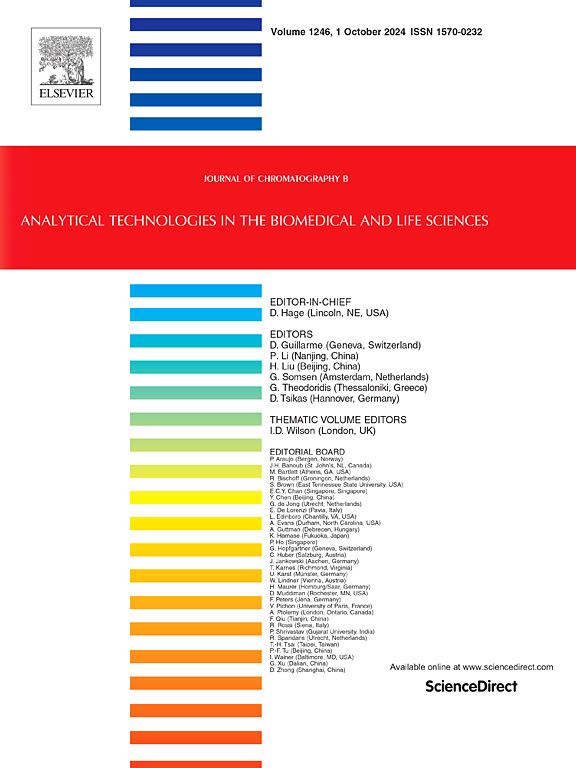苹果多酚氧化酶的分离纯化及动力学性质研究
IF 2.8
3区 医学
Q2 BIOCHEMICAL RESEARCH METHODS
引用次数: 0
摘要
本研究提出了一种纯化多酚氧化酶(PPO)的新方法。为此,首先用溴化氰(CNBr)活化Sepharose-4B,然后将l -酪氨酸(作为间隔臂)偶联到CNBr活化的Sepharose-4B上,然后将邻氨基苯甲酸作为纯化PPO的配体偶联到l -酪氨酸上,合成了一种新型亲和凝胶。利用Sepharose 4b - l -酪氨酸-对氨基苯甲酸亲和凝胶和新型亲和凝胶分别从Isparta/ trkiye Eğirdir地区的Starking Delicious、Granny Smith和Golden Delicious苹果品种中纯化了PPO酶。该凝胶分别对Starking Delicious、Granny Smith和Golden Delicious三个品种进行了101.59、22.69和12.81倍的纯化。Sepharose 4b - l -酪氨酸-对氨基苯甲酸在Starking Delicious、Granny Smith和Golden Delicious的纯化率分别为128.95、25.60和45.92倍。Km、Vmax和Vmax/Km分别为20 mM、25,000 U/mLmin和1,250 U/mLminmM;40mm、20000 U/mLmin、500u /mLminmM;以儿茶酚为底物,linewever - burk法纯化了Starking Delicious、Granny Smith和Golden Delicious品种的PPO酶,分别为50 mM、5000 U/mLmin和100 U/mLmin。本研究探讨了亲和层析纯化中对取代基和邻位取代基定位对配体性能的影响。研究结果表明,使用邻氨基苯甲酸配体的新型亲和凝胶可以有效地纯化PPO,突出了配体结构在亲和色谱中的重要性,并对酶的纯化有重要贡献。本文章由计算机程序翻译,如有差异,请以英文原文为准。
Development of an alternative method for purification and kinetic properties of polyphenol oxidase from some apple cultivars
In this study, an alternative method to purify the polyphenol oxidase (PPO) was developed. For this purpose, a novel affinity gel was synthesized by first Sepharose-4B being activated by cyanogen bromide (CNBr), then L-tyrosine (as a spacer arm) was coupled to CNBr-activated Sepharose-4B, and then o-aminobenzoic acid, as a ligand for purification of the PPO, was coupled to L-tyrosine. PPO enzymes were purified from Starking Delicious, Granny Smith, and Golden Delicious apple cultivars grown in the Eğirdir district of Isparta/Türkiye by utilizing both the Sepharose 4B-L-tyrosine-p-aminobenzoic acid affinity gel and the novel affinity gel. 101.59, 22.69, and 12.81 purification folds were achieved from Starking Delicious, Granny Smith, and Golden Delicious cultivars, respectively, by using the novel gel. 128.95, 25.60, and 45.92 purification folds were achieved in the Starking Delicious, Granny Smith, and Golden Delicious cultivars, respectively, by utilizing Sepharose 4B-L-tyrosine-p-aminobenzoic acid. The Km, Vmax, and Vmax/Km values were calculated to be 20 mM, 25,000 U/mLmin, and 1,250 U/mLminmM; 40 mM, 20,000 U/mLmin, and 500 U/mLminmM; and 50 mM, 5,000 U/mLmin, and 100 U/mLminmM for the purified PPO enzymes of the Starking Delicious, Granny Smith, and Golden Delicious cultivars, respectively, by using catechol as substrate by the Lineweaver-Burk method. This study investigated the effect of para and ortho substituent positioning on ligand performance in affinity chromatography purification. The findings show that a novel affinity gel using an o-aminobenzoic acid ligand is effective for PPO purification, highlights the importance of ligand structure in affinity chromatography, and contributes significantly to enzyme purification.
求助全文
通过发布文献求助,成功后即可免费获取论文全文。
去求助
来源期刊

Journal of Chromatography B
医学-分析化学
CiteScore
5.60
自引率
3.30%
发文量
306
审稿时长
44 days
期刊介绍:
The Journal of Chromatography B publishes papers on developments in separation science relevant to biology and biomedical research including both fundamental advances and applications. Analytical techniques which may be considered include the various facets of chromatography, electrophoresis and related methods, affinity and immunoaffinity-based methodologies, hyphenated and other multi-dimensional techniques, and microanalytical approaches. The journal also considers articles reporting developments in sample preparation, detection techniques including mass spectrometry, and data handling and analysis.
Developments related to preparative separations for the isolation and purification of components of biological systems may be published, including chromatographic and electrophoretic methods, affinity separations, field flow fractionation and other preparative approaches.
Applications to the analysis of biological systems and samples will be considered when the analytical science contains a significant element of novelty, e.g. a new approach to the separation of a compound, novel combination of analytical techniques, or significantly improved analytical performance.
 求助内容:
求助内容: 应助结果提醒方式:
应助结果提醒方式:


